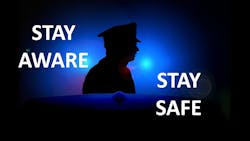As we’ve witnessed in New York City recently, being a police officer has become more dangerous than ever. Officers responding to calls for help and arresting lawbreakers have been subject to verbal and physical assaults. There are myriad reasons why this latest outbreak of disrespect and lawlessness is occurring, not the least of which is that many city administrations punish cops that respond to the assaults, rather than the thugs that commit the acts. In private conversations, some officers admit to dialing down their activity, hardly doing any proactive policing and responding to radio assignments slowly and reluctantly.
That aside, let’s review how to stay safe in your role as a police officer. Situational awareness is even more imperative in the current climate. Knowing what’s happening in your environment will help keep you safe and healthy. But being aware of everything around you has become more difficult than ever. Keeping focused on an offender(s) is paramount. However, in certain areas crowds form quickly and threats from them become almost certain. Add into the equation technologies such as radios, cell phones, and laptops, items that were supposed to help a cop do his job better but that might just cause his attention to them to be the very thing that gets him hurt.
Injuries
We’ve seen objects being thrown at officers while they’re engaged with an offender or using their radios or laptops. Their attention is drawn away from their environment temporarily, and that’s when the likelihood of being injured is great. This isn’t hyperbole. Last year, the National Institute of Occupational Safety and Health published a report relating to non-fatal injuries suffered by police officers between 2003 and 2014. Cops are three times more likely to be injured on the job than all other U.S. workers. The study found that more than 669,000 officers were treated in ERs, the leading cause being assaults and violent acts.
Being aware
Being aware of your situation and environment is the key to staying safe. It’s difficult to be totally aware when one is involved in a high-stress situation such as an arrest, street stop, or traffic stop. But some things can help you dial into your situation quickly.
Identify threats: Quickly gauge the most likely threats around you, whether they are people or objects. If you’re familiar with a certain gang area, i.e., realize that it’s likely members will harass or attack you. Traffic stops or street stops near high-rises may result in objects being thrown at you. Abandoned buildings pose hidden threats, as do debris and garbage in the streets. Such things become potential missiles.
Trust you gut: Learn from past experiences. When you’ve been in similar circumstances, remember the outcome and threats that presented themselves to you. If you have a bad feeling about something, pay attention because your mind is trying to steer you in the right direction.
Constantly check your 6: Common sense, right? But when you’re involved in a stressful situation and focused on something, that’s when it’s important to watch your back. It’s tough to take your eyes off what’s happening even for a second, but it just may save your life. Scanning and using your peripheral vision will help. If you can, try to back up against a tree or building to at least minimize any attacks from behind. Also, use any reflective surfaces in the area, such as car windows, storefronts, etc.
Constantly assess the situation: Sometimes there is a tendency to wait until it’s too late to get help. You must constantly assess what’s going on and realize when a situation is likely to accelerate and explode. Don’t be reluctant to get others on scene quickly. For that matter, if something escalates immediately before help arrives, don’t hesitate to retreat and regroup. Even if you’re about to arrest a subject and things begin to go south, it’s likely you’ll run into the same thug again sometime in the future. Let him go.
Training
Training can help officers adjust to situations they encounter. High stress situations such as active shooters, felony traffic stops, etc., can be addressed through force on force or simulators. The advantage to this type of training is that immediate feedback is helpful, and the training scenario can be run again correctly to reinforce the proper response. Scenarios can be specific to the department or agency to create even more realism.
Even the Army now recognizes the importance of training for situational awareness. The U.S. Army Maneuver Center of Excellence (MCoE) is addressing this need with a unique course called Advanced Situational Awareness (ASA). The course teaches soldiers the art and science of observing humans and their surrounding environment. The ASA course grew from the recognition that soldiers needed more training to enhance their awareness, sharpen their mindset, and increase their ability to secure themselves and their units in the complex environments in foreign countries as well as here at home.
Training for situational awareness is paramount for our modern warriors, enabling them to predict threats and act decisively and appropriately. Violence is on the rise on our streets and it’s imperative that we are prepared to deal with it.
Stay Safe, Brothers and Sisters!
About the Author
John Wills
John M. Wills is a former Chicago police officer and retired FBI agent. He is a freelance writer and award-winning author in a variety of genres, including novels, short stories and poetry. John also writes book reviews for the New York Journal of Books, and is a member of the National Book Critics Circle. His new book, The Year Without Christmas, is available now. Visit John at: www.johnmwills.com.

